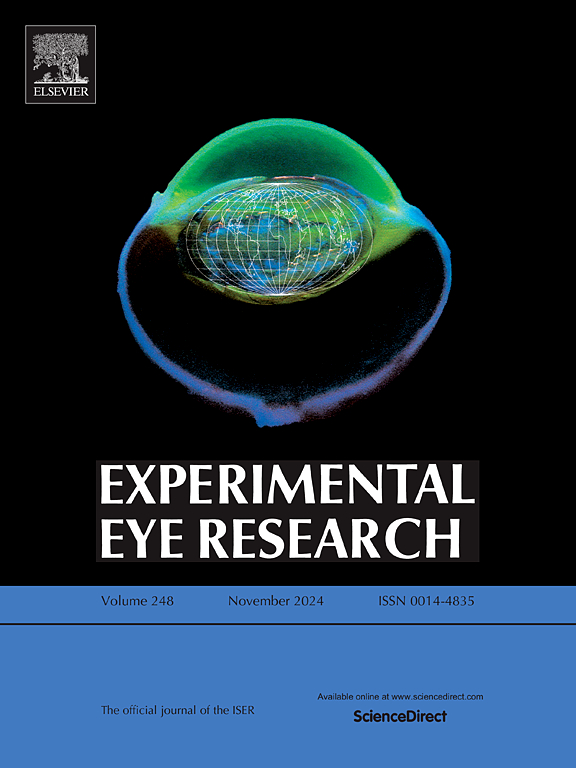枸杞糖肽通过调节NF-κB/NLRP3/IL-1 β信号通路和microRNA-21a-5p/SMAD7减少角膜损伤的炎症和纤维化。
IF 3
2区 医学
Q1 OPHTHALMOLOGY
引用次数: 0
摘要
枸杞糖肽(LbGp)是从中药植物枸杞中提取的,具有抗炎作用;然而,其在角膜损伤后修复中的确切作用和机制尚不清楚。本研究采用小鼠体内角膜碱烧伤模型和体外人角膜细胞纤维化模型,探讨LbGp对碱烧伤后角膜修复的作用机制及作用机制。通过裂隙灯显微镜评估角膜炎症、混浊和上皮缺损。结果显示,与磷酸盐缓冲盐水(PBS)处理的对照组相比,lbp处理的小鼠水肿减少,再上皮化加速,角膜混浊降低。蛋白质组学分析显示,在对照组、损伤组和LbGp治疗组中,细胞外基质中富集了改变的蛋白质。此外,LbGp显著减弱tgf β-1诱导的肌成纤维细胞从角化细胞转分化。与此一致的是,LbGp治疗抑制了角膜碱烧伤后纤维化标志物(αSMA、纤维连接蛋白和III型胶原)蛋白和mRNA水平的上调。LbGp还能有效抑制角膜碱烧伤后NF-κB/NLRP3/IL-1β信号通路的激活和中性粒细胞的浸润。此外,在tgf β-1刺激的角质细胞和碱烧伤小鼠角膜中,miR-21表达上调。LbGp降低miR-21的表达,同时增加其靶点Smad7的表达,从而抑制TGFβ/Smad2/3信号通路。本研究表明LbGp通过抑制碱烧伤后的炎症和纤维化促进角膜愈合,提示其有可能作为角膜损伤修复的补充疗法。本文章由计算机程序翻译,如有差异,请以英文原文为准。
Lycium barbarum glycopeptide reduces inflammation and fibrosis in corneal injury by modulating the NF-κB/NLRP3/IL-1 β signaling pathway and microRNA-21a-5p/SMAD7
Lycium barbarum glycopeptide (LbGp), derived from the Chinese medicinal plant Lycium barbarum, has demonstrated anti-inflammatory properties; however, its precise role and mechanism in corneal repair following injury remain elusive. The present research investigated the mechanisms and effects of LbGp on corneal repair following alkali burn injury using in vivo mouse models of corneal alkali burn and in vitro human keratocyte fibrosis models. Corneal inflammation, opacity, and epithelial defects were assessed via a slit lamp microscope. Results showed that LbGp-treated mice exhibited reduced edema, accelerated re-epithelialization, and decreased corneal opacity compared to the phosphate-buffered saline (PBS)-treated controls. Proteomic analysis revealed altered proteins enriched in the extracellular matrix among the control, injury, and LbGp treatment groups. Moreover, LbGp significantly attenuated TGFβ-1-induced myofibroblasts transdifferentiation from keratocytes. Consistently, LbGp treatment inhibited the upregulation of fibrosis markers (αSMA, fibronectin, and collagen III) at both the protein and mRNA levels after corneal alkali burns. LbGp also effectively suppressed the activation of the NF-κB/NLRP3/IL-1β signaling pathway and neutrophil infiltration following corneal alkali burn injury. Additionally, miR-21 was upregulated in TGFβ-1-stimulated keratocytes and in the alkali-burned mouse cornea. LbGp decreased miR-21 expression, while increasing expression of its target, Smad7, thereby dampening the TGFβ/Smad2/3 signaling pathway. This research demonstrates that LbGp promotes corneal healing by inhibiting inflammation and fibrosis after alkali burns, suggesting its potential as a supplementary therapy for corneal injury repair.
求助全文
通过发布文献求助,成功后即可免费获取论文全文。
去求助
来源期刊

Experimental eye research
医学-眼科学
CiteScore
6.80
自引率
5.90%
发文量
323
审稿时长
66 days
期刊介绍:
The primary goal of Experimental Eye Research is to publish original research papers on all aspects of experimental biology of the eye and ocular tissues that seek to define the mechanisms of normal function and/or disease. Studies of ocular tissues that encompass the disciplines of cell biology, developmental biology, genetics, molecular biology, physiology, biochemistry, biophysics, immunology or microbiology are most welcomed. Manuscripts that are purely clinical or in a surgical area of ophthalmology are not appropriate for submission to Experimental Eye Research and if received will be returned without review.
 求助内容:
求助内容: 应助结果提醒方式:
应助结果提醒方式:


